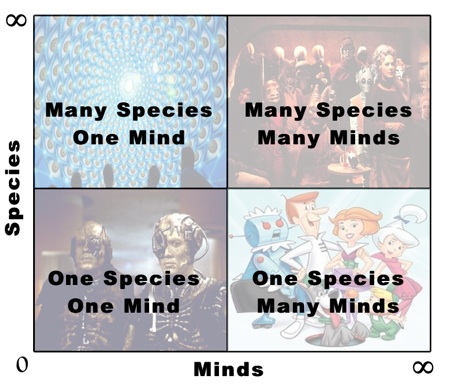Many Species, One Mind
[Translations: Japanese]
As George Dyson demonstrates in his wonderful history of the network mind, “Darwin Among The Machines: The Evolution Of Global Intelligence”, the idea of a global brain hatched at the very beginning of the technological era. As soon as we created “machines,” we began to imagine “machine brains” and more importantly “one machine brain.” As soon as we gave machines autonomous energy, we could see them having autonomous minds.
Dyson’s book focused on the astonishing prescient visions of a global machine intelligence from the historical likes of Samuel Butler, Leibniz, Babbage, and Olaf Stapledon. After the book was done Dyson sat down on the deck of his workshop with a yellow legal pad to draft the introduction, and there compressed all the possible future paths of humanity into one brief couplet:
Do we remain one species, or diverge into many?
Do we remain of many minds, or merge into one?
I’d like to carve that refrain into stone somewhere. In those two verses lay the four great long-term scenarios for the human race:

One species, many minds: The official future. We interbreed among our genetic improvements and keep our individuality distinct, and our species identity intact.
One species, one mind: Through electronic mediation, we join together to create a superorganism. A suprahuman. I originally called this the Borg but was reminded that the Borg is many species assimilated.
Many species, many minds: Star Wars World. Ultimate diversity. Humans fork in their evolution to create new breeds. Some may even join machines in cyborgian partnerships.
Many species, one mind: We fork in biology but unite in the noosphere. Millions of species share the same mind. The scariest and hardest scenario to contemplate. The dark version of this is the Star Trek nemesis, the Borg. I don’t know if there is a welcoming version in science fiction.
I used to think that scenario #3 – many species, many minds — was the future to aim for, but after reading Dyson I think that “many species, one mind” is the way to go. That phrase MANY SPECIES, ONE MIND is not a bad bumper sticker for this new destiny.
In correspondence George Dyson suggested, “A lot of us probably feel we would prefer scenario #3, or believe it offers the richest future, with maximum insurance (via diversity) against catastrophe. However as in scenario #4 (Many species, one mind) there may be some inherent force (or fortuitous balance of forces) in the universe that causes species to tend to diversify and minds to tend to unify.”
Unity as a destination is a new idea for me. My reading of evolution – as outlined in this blog — suggests that what organic evolution “wants” is fundamental diversity, as in a diversity of evolutions. The evolution of technology, too, is headed toward more ways of searching, more ways of creation, as well as more ways of being. Evolution of both life and technology tend toward increasing varieties, specialties, complexity, and diversity of choices. In that way evolution is divergent.
But what if there IS a tendency toward unity, at least in technology. What if technological evolution is not divergent, but convergent?
Dyson again: “Evolution and communication networks are both branching processes, with the difference that speciation is in the business of making DIS-connections, while communication networks (electrical, chemical, whatever) are in the business of making (and maintaining) connections. What is interesting is that in biological evolution speciation has been spectacularly successful whereas in cultural evolution speciation (into isolated religious groups, etc) has generally failed. Freeman [Dyson’s father] would say that failure is just because there isn’t enough room on the planet, and that cultural speciation will flourish in outer space (your Star Wars scenario #3) but I’m not so sure.”
It may be that a difference between biological and technology evolution – in addition to the fact that extinction is a method in biology but not technology – is that biology diverges and technology converges.
However, we could also say that the platform is simply evolution, and that in its seventh kingdom, life converges. On Earth there many species, but only one life. All life on earth is running the same OS. So we could say: on earth, many species, one evolution. And if, as Dyson argues in his book, evolution is a type of slow distributed intelligence, then we already have many species, one mind.
But the “one mind” of evolution is not at all like the One Mind of a global superorganism. The One Mind is a composite of many minds. That is a kind of mind we don’t have a word for yet. This mega-level mind does things that no mere mind composed of non-minds can do.
There is something engulfing within the nature of a mind. A mind wants to devour, to suck in other intelligence. It seeks out other intelligences and wants to meld. We see that in the fierce impulse to share on the web. Human minds, at least, want to enter into other human minds. We yearn for telepathy. A mind inherently wants to expand. The logical destiny is One Mind.
At the same time, there is a definite trend in history to increasing the variety of minds – the many species of mind we see in animals and now in devices. While minds crave unity, they also want diversity, different ways of thinking. Perhaps that is what we get with MANY SPECIES, ONE MIND.


